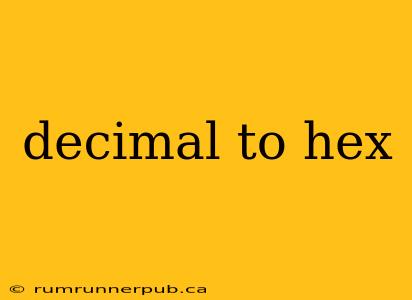Converting between decimal (base-10) and hexadecimal (base-16) number systems is a fundamental skill in computer science and programming. Hexadecimal, often shortened to "hex," is widely used to represent memory addresses, colors (e.g., in HTML and CSS), and other data in a more compact and human-readable format than its binary counterpart. This article will explore various methods for decimal to hexadecimal conversion, drawing upon insights from Stack Overflow and expanding upon them with practical examples and additional explanations.
Understanding the Basics
Before diving into the conversion methods, let's briefly review the number systems involved:
-
Decimal (Base-10): Uses digits 0-9. Each position represents a power of 10 (1, 10, 100, 1000, etc.). For example, 123410 = 1103 + 2102 + 3101 + 4100.
-
Hexadecimal (Base-16): Uses digits 0-9 and letters A-F, where A=10, B=11, C=12, D=13, E=14, and F=15. Each position represents a power of 16 (1, 16, 256, 4096, etc.). For example, 1A16 = 1161 + 10160 = 16 + 10 = 2610.
Methods for Decimal to Hexadecimal Conversion
There are several approaches to convert a decimal number to its hexadecimal equivalent. Let's examine the most common ones:
1. Repeated Division by 16:
This is a widely used algorithm, often explained in Stack Overflow answers (although rarely explicitly detailed). The process involves repeatedly dividing the decimal number by 16 and recording the remainders. The remainders, read in reverse order, form the hexadecimal representation.
Example: Convert 25510 to hexadecimal.
| Division | Quotient | Remainder (Hex) |
|---|---|---|
| 255 / 16 | 15 | F |
| 15 / 16 | 0 | F |
Reading the remainders from bottom to top, we get FF16. Therefore, 25510 = FF16.
This method, while fundamental, can become cumbersome for large decimal numbers.
2. Using Built-in Programming Language Functions:
Most programming languages provide built-in functions to simplify this conversion. For example:
-
Python:
hex(decimal_number)decimal_number = 255 hex_number = hex(decimal_number) # Output: 0xff print(hex_number) -
JavaScript:
decimal_number.toString(16)let decimalNumber = 255; let hexNumber = decimalNumber.toString(16); // Output: ff console.log(hexNumber); -
C++:
std::hexmanipulator withinstd::cout#include <iostream> #include <iomanip> int main() { int decimalNumber = 255; std::cout << std::hex << decimalNumber << std::endl; // Output: ff return 0; }
These functions offer a concise and efficient way to perform the conversion, especially for larger numbers. Note that some functions might include a "0x" prefix to explicitly indicate the hexadecimal representation.
3. Understanding the Bit Pattern (Advanced):
For a deeper understanding, consider the underlying bit pattern. Each hexadecimal digit represents 4 bits. You can convert the decimal number to binary first and then group the bits into sets of four, converting each set to its hexadecimal equivalent. This approach is helpful when working with bit manipulation at a lower level. (This method is frequently discussed in relevant Stack Overflow threads dealing with bitwise operations.)
Practical Applications and Further Exploration
Hexadecimal conversion is crucial in many areas:
- Web Development: Defining colors using hex codes (e.g.,
#FF0000for red). - Computer Graphics: Representing pixel colors and other image data.
- Network Programming: Working with MAC addresses and IP addresses.
- Embedded Systems: Interfacing with hardware registers and memory locations.
This article provides a solid foundation for understanding decimal to hexadecimal conversion. Further exploration might include investigating different bases (binary, octal), and exploring more advanced techniques for bit manipulation. Remember to always consult relevant Stack Overflow threads and documentation for your specific programming language when tackling more complex scenarios. Understanding the fundamentals and leveraging the power of built-in functions will enable you to confidently handle decimal-to-hexadecimal conversions in your programming tasks.
